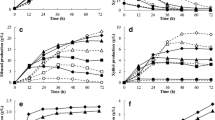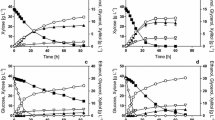Abstract
Glucose/xylose mixtures (90 g/L total sugar) were evaluated for their effect on ethanol fermentation by a recombinant flocculent Saccharomyces cerevisiae, MA-R4. Glucose was utilized faster than xylose at any ratio of glucose/xylose, although MA-R4 can simultaneously co-ferment both sugars. A high percentage of glucose can increase cell biomass production and therefore increase the rate of glucose utilization (1.224 g glucose/g biomass/h maximum) and ethanol formation (0.493 g ethanol/g biomass/h maximum). However, the best ratio of glucose/xylose for the highest xylose consumption rate (0.209 g xylose/g biomass/h) was 2:3. Ethanol concentration and yield increased and by-product (xylitol, glycerol, and acetic acid) concentration decreased as the proportion of glucose increased. The maximum ethanol concentration was 41.6 and 21.9 g/L after 72 h of fermentation with 90 g/L glucose and 90 g/L xylose, respectively, while the ethanol yield was 0.454 and 0.335 g/g in 90 g/L glucose and 90 g/L xylose media, respectively. High ethanol yield when a high percentage of glucose is available is likely due to decreased production of by-products, such as glycerol and acetic acid. These results suggest that ethanol selectivity is increased when a higher proportion of glucose is available and reduced when a higher proportion of xylose is available.


Similar content being viewed by others
References
Jordan, D. B., Bowman, M. J., Braker, J. D., Dien, B. S., Hector, R. E., Lee, C. C., et al. (2012). Biochemical Journal, 442, 241–252.
Balat, M., Balat, H., & Öz, C. (2008). Progress in Energy and Combustion Science, 34, 551–573.
Chen, Y. (2011). Journal of Industrial Microbiology & Biotechnology, 38, 581–597.
Taniguchi, M., & Tanaka, T. (2004). Advances in Biochemical Engineering/Biotechnology, 90, 35–62.
Olsson, L., & Hahn-Hägerdal, B. (1993). Process Biochemistry, 28, 249–257.
Cai, Z., Zhang, B., & Li, Y. (2012). Biotechnology Journal, 7, 34–46.
Madhavan, A., Srivastava, A., Kondo, A., & Bisaria, V. S. (2012). Critical Reviews in Biotechnology, 32, 22–48.
Matsushika, A., Liu, Z. L., Sawayama, S., & Moon, J. (2012). Microbiology Monographs, vol. 22. In Z. L. Liu (Ed.), Microbial stress tolerance for biofuels (pp. 137–160). Heidelberg: Springer.
Matsushika, A., Inoue, H., Kodaki, T., & Sawayama, S. (2009). Applied Microbiology and Biotechnology, 84, 37–53.
Van Vleet, J. H., & Jeffries, T. W. (2009). Current Opinion in Biotechnology, 20, 300–306.
Matsushika, A., Inoue, H., Murakami, K., Takimura, O., & Sawayama, S. (2009). Bioresource Technology, 100, 2392–2398.
Matsushika, A., Inoue, H., Watanabe, S., Kodaki, T., Makino, K., & Sawayama, S. (2009). Applied and Environmental Microbiology, 75, 3818–3822.
Sunitha, K., Lee, J. K., & Oh, T. K. (1999). Bioprocess and Biosystems Engineering, 21, 477–481.
Silva, J. P., Mussatto, S. I., & Roberto, I. C. (2010). Applied Biochemistry and Biotechnology, 162, 1306–1315.
Matsushika, A., & Sawayama, S. (2010). Applied Biochemistry and Biotechnology, 162, 1952–1960.
Kuriyama, H., Seiko, Y., Murakami, T., Kobayashi, H., & Sonoda, Y. (1985). Journal of Fermentation Technology, 63, 159–165.
Matsushika, A., Watanabe, S., Kodaki, T., Makino, K., Inoue, H., Murakami, K., et al. (2008). Applied Microbiology and Biotechnology, 81, 243–255.
Govindaswamy, S., & Vane, L. M. (2007). Bioresource Technology, 98, 677–685.
Agbogbo, F. K., Coward-Kelly, G., Torry-Smith, M., & Wenger, K. S. (2006). Process Biochemistry, 41, 2333–2336.
Zhao, L., Zhang, X., & Tan, T. (2008). Biomass and Bioenergy, 32, 1156–1161.
Hamacher, T., Becker, J., Gárdonyi, M., Hahn-Hägerdal, B., & Boles, E. (2002). Microbiology, 148, 2783–2788.
Matsushika, A., Goshima, T., Fujii, T., Inoue, H., Sawayama, S., & Yano, S. (2012). Enzyme and Microbial Technology, 51, 16–25.
Matsushika, A., & Sawayama, S. (2012). Applied Biochemistry and Biotechnology, 168, 2094–2104.
Acknowledgments
The authors would like to thank Dr. Tamotsu Hoshino, Dr. Shinichi Yano, Dr. Kazuhiko Ishikawa, Dr. Katsuji Murakami, Dr. Osamu Takimura, Dr. Hiroyuki Inoue, Dr. Kenichiro Tsukahara, Dr. Tatsuya Fujii and Dr. Tetsuya Goshima (AIST) for helpful discussion, and Ms. Maiko Kato for her technical assistance. This study was supported by the New Energy and Industrial Technology Development Organization (NEDO), Japan.
Author information
Authors and Affiliations
Corresponding author
Rights and permissions
About this article
Cite this article
Matsushika, A., Sawayama, S. Characterization of a Recombinant Flocculent Saccharomyces cerevisiae Strain that Co-ferments Glucose and Xylose: I. Influence of the Ratio of Glucose/Xylose on Ethanol Production. Appl Biochem Biotechnol 169, 712–721 (2013). https://doi.org/10.1007/s12010-012-0013-1
Received:
Accepted:
Published:
Issue Date:
DOI: https://doi.org/10.1007/s12010-012-0013-1




